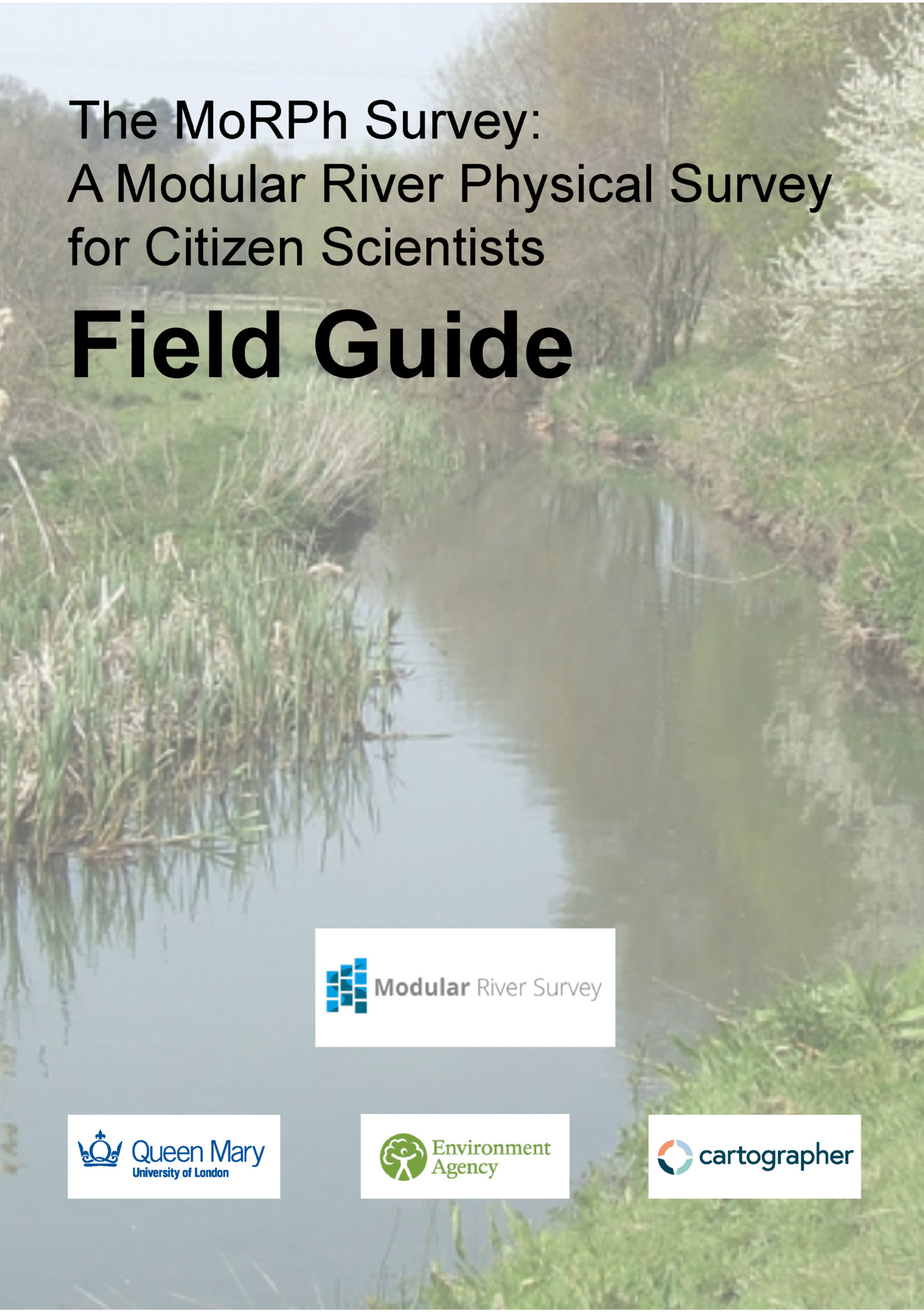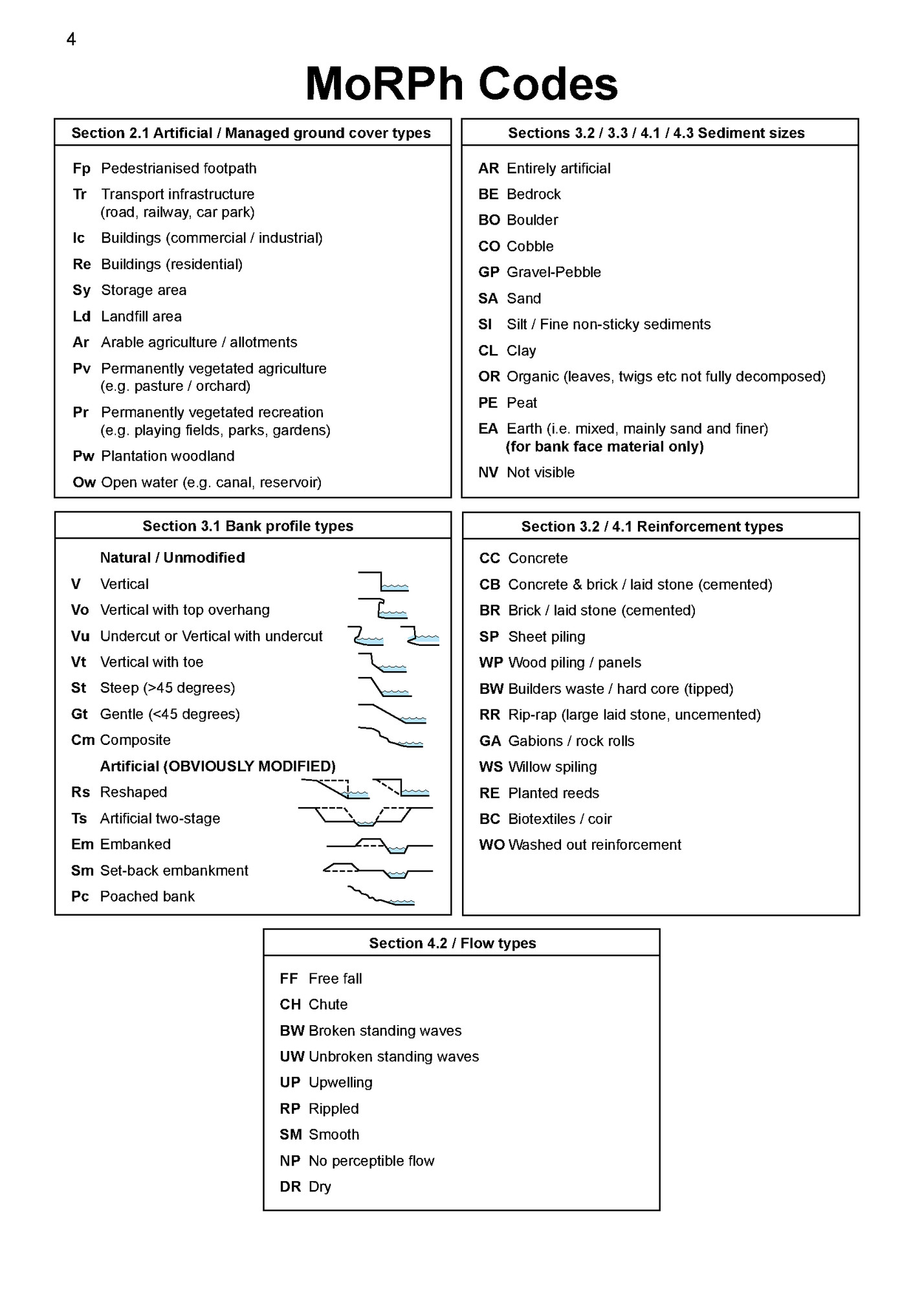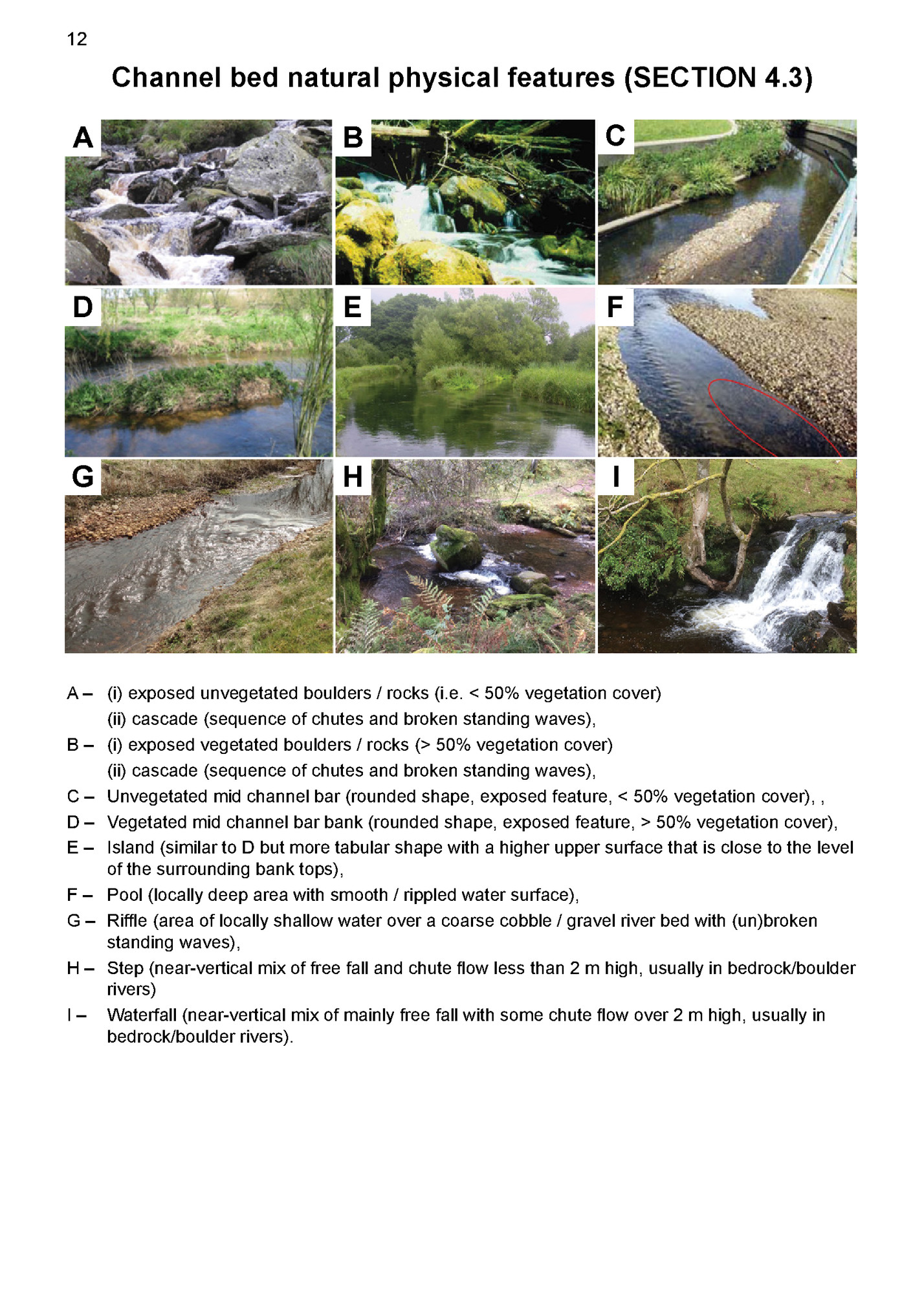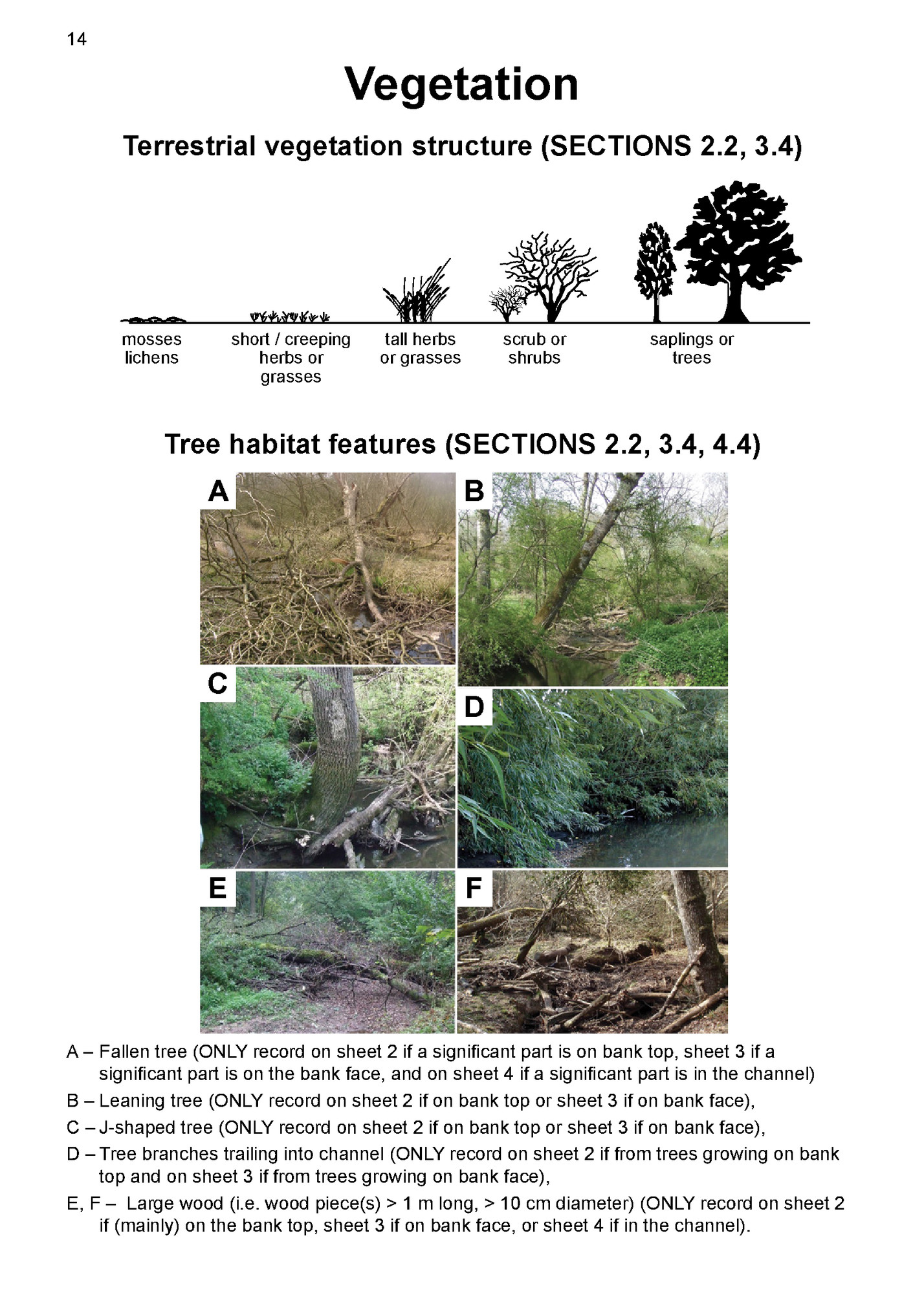The MoRPh Survey: A Modular River Physical Survey for Citizen Scientists Field Guide

The MoRPh survey is one part of the Modular River Survey suite of scaled assessment techniques that are designed to promote understanding of the way rivers function across a hierarchy of spatial scales within a river catchment (see www. modularriversurvey.org). This guide was prepared by Angela Gurnell, Judy England, Lucy Shuker and Geraldene Wharton and the supporting software was developed by David Gurnell. The MoRPh survey was developed for Citizen Scientists to support the Catchment Based Approach and river stewardship for Catchment Partnerships and is now being more widely adopted for river assessment and monitoring. This Field Guide: • is not a complete manual but is designed to be used in the field to support the completion of the four sheets of the MoRPh Field Survey. • provides images and brief supporting text to act as an aide memoire for field surveyors • uses the same numbering system as the four field sheets to indicate where each part of the Field Guidance can support the completion of the four survey sheets. • uses the same numbering system as the MoRPh Technical Reference Manual to indicate where more detailed information can be found on each element of the MoRPh survey. • the numbering system starts with the MoRPh survey sheet number (1 to 4) and is then followed by the section number on each sheet. For example 3.2 refers to sheet 3 section 2. MoRPh Field Guide 2019. • The field guide is organised into five parts: MoRPh Codes Setting up the survey Materials Natural and Artificial Physical Features Vegetation

5 MoRPh Codes Section 2.1 Artificial / Managed ground cover types Sections 3.2 / 3.3 / 4.1 / 4.3 Sediment sizes Fp Pedestrianised footpath AR Entirely artificial Tr Transport infrastructure (road, railway, car park) BE Bedrock Ic BO Boulder Buildings (commercial / industrial) CO Cobble Re Buildings (residential) GP Gravel-Pebble Sy Storage area SA Sand Ld Landfill area Module, Subreach, Reach Names / Numbers (SECTION 1.2) Surveyed modules (numbered) are located within a subreach (local name) which is located within a reach (river name). Module length varies with MoRPh river width. Where several contiguous MoRPh surveys are to be conducted, use a single module length based on the typical river width and number modules from upstream (module 1) to downstream. SI Silt / Fine non-sticky sediments Ar Arable agriculture / allotments CL Clay Pv Permanently vegetated agriculture (e.g. pasture / orchard) OR Organic (leaves, twigs etc not fully decomposed) PE Peat Pr Permanently vegetated recreation (e.g. playing fields, parks, gardens) River width (m) (ii) Module length (m) <5m 10 m 5 to < 10 m 20 m 10 to < 20 m 30 m NV Not visible 20 to < 30 m 40 m ≥ 30 m Ow Open water (e.g. canal, reservoir) Width of regularly inundated bare sediment, marginal/emergent plants Low flow water width Determining your Module Length EA Earth (i.e. mixed, mainly sand and finer) (for bank face material only) Pw Plantation woodland River channel too wide for this type of survey Section 3.1 Bank profile types Section 3.2 / 4.1 Reinforcement types Natural / Unmodified V Setting Up the Survey CC Concrete Vertical CB Concrete & brick / laid stone (cemented) Vo Vertical with top overhang SP Sheet piling Vt Vertical with toe WP Wood piling / panels St Steep (>45 degrees) BW Builders waste / hard core (tipped) Gt Gentle (<45 degrees) RR Rip-rap (large laid stone, uncemented) Cm Composite MoRPh river width This is estimated as the typical water width plus any area of bare sediment or emergent aquatic plants at the edge of the water. BR Brick / laid stone (cemented) Vu Undercut or Vertical with undercut Predominant river width is used to determine module length. GA Gabions / rock rolls B C Artificial (OBVIOUSLY MODIFIED) A D WS Willow spiling Rs Reshaped RE Planted reeds Ts Artificial two-stage BC Biotextiles / coir Em Embanked WO Washed out reinforcement Sm Set-back embankment Pc Poached bank Section 4.2 / Flow types FF Free fall CH Chute BW Broken standing waves UW Unbroken standing waves UP Upwelling RP Rippled SM Smooth NP No perceptible flow DR Dry Yellow arrows indicate the ‘MoRPh river width’, red dashed lines indicate the boundary between the bank face and the bank top. (photographs provided by the Environment Agency).

7 Materials Survey layout and channel dimensions (SECTION 1.3) The MoRPh survey records information for: • the left and right bank top (10 m back from the bank edge) (Survey sheet 2) • the left and right bank face (includes margins of the water-filled channel) (Survey sheet 3) Bank face (SECTION 3.2) and channel bed (SECTION 4.1) natural materials Sediment size codes are used to record natural bank and bed materials. The following table provides some simple descriptions (in red) that can be used in the field. Note that EA is only used for bank materials. • the channel bed (Survey sheet 4). 10 m el d 10 m be ht rig Low flow channel width is between 5 and 10 m. Therefore, module length is 20 m Only record if artificial materials (e.g. concrete) completely obscure the natural sediments across the entire bank face or river bed Bedrock Bare bedrock exposed at the surface Boulder Mineral particles, diameter > 256 mm head size or larger CO Cobble Mineral particles, diameter 64-256 mm fist size to head size GravelPebble Mineral particles, diameter 2-64 mm Smaller than fist size but particles clearly visible to naked eye from several meters SA Sand Mineral particles, diameter 0.0625-2 mm very loose crumbly material, particles clearly visible to naked eye from within 1 m. SI Silt (and finer nonsticky particles) Mineral particles, diameter 0.00195-0.0625 mm loose crumbly material but individual particles difficult to see with the naked eye CL Clay Mineral particles, diameter < 0.00195 mm sticky material made up of very small particles invisible to the naked eye) Organic Dead plant material (leaves, twigs etc.) that is intact or only lightly decomposed PE Peat More or less decomposed plant material that has accumulated in a water-saturated environment and in the absence of oxygen EA Earth A mixture of mineral and organic particle sizes (mainly sand and finer) (only used for bank face material) NV op kt n ba Artificial Not visible Only record if all natural sediments are present but obscured from view (e.g. by vegetation, when observed from the opposite river bank) Right bank face / channel margin Channel bed ce m k fa an 20 tb h rig AR BE Right bank top / floodplain Technical Description BO Left bank face / channel margin e n an ch width = 8 m ac kf an tb lef Left bank top / floodplain Name OR op kt n ba Code GP t lef flow direction surveyed channel cross section Left bank Right bank Channel dimensions are recorded at a representative site within the surveyed module, usually at a riffle or run, where the water is relatively shallow. 1 MoRPh river width 2 Left bank height 3 Right bank height 4 Bankfull width 5 Water width 6 Water depth 4 2 5 3 6 1 Left bank Right bank Simple Field Description

Bank face (SECTION 3.2) and channel bed (SECTION 4.1) reinforcement Reinforcement type codes are used to record bank and bed reinforcement materials CC CB BR 9 Natural and Artificial Physical Features Natural / artificial bank profiles (SECTION 3.1) Natural / Unmodified bank profile V: Vertical Vo: Vertical with top overhang Vu: Undercut or vertical + undercut Vt: Vertical with toe SP WP BW St: Steep (>45 degrees) Gt: Gentle (<45 degrees) Cm: Composite Artificial bank profile Rs: Reshaped RR GA WS Ts: Artificial two-stage Em: Embanked Sm: Set-back embankment Pc: Poached bank RE BC WO Bank top water-related features (SECTION 2.3 AND 3.3) 1 Side Channel 2 Pond connected Connected to main channel at both ends. Water flows in one direction. CC - concrete (cemented reinforcement with no gaps), CB - concrete and brick, blocks or stone (areas of extensive concrete with areas of bricks/ stone/concrete blocks), BR - brick / laid stone / blocks (held together by mortar), SP - sheet piling (interlocking metal sheets, including corrugated iron), WP - wood piling (vertical or horizontal wood planks protecting the bank face), BW - builders waste (loose, tipped hard core), RR - rip-rap (uncemented stones/blockstones/boulders, often of similar size, purposely tipped/ laid along the bank), GA - gabions (stones in wire baskets), WS - willow spiling / faggot bundles (cut willow stakes driven into bank toe / face, often linked by woven willow pieces, or bundles of sticks or twigs), RE - planted reeds (only record when obviously deliberately planted), BC - biotex / coir (woven fabric spread to protect the underlying bank materials from erosion), WO - washed out (bank protection materials that have collapsed into the river channel). One connection to main channel at low flow. Water can flow in two directions. 2 1 3 3 Marginal backwater Embayment in main channel margin. Very slow water movement with secondary circulation during higher flows. 4 4 Pond disconnected Only connected to main channel during high flow. Features 1, 2 and 4 are recorded in section 2.3 and feature 3 is recorded in section 3.3

Bank face – channel margin, Natural physical features (SECTION 3.3) A B Bank face – channel margin, Artificial physical features (SECTION 3.3) Major jetty: extends > 20% channel width (water cannot flow underneath) Intermediate jetty: extends 10–20% channel width Minor jetty: extends <10 channel width C D 11 Major deflector: extends >20% channel width (water cannot flow underneath, includes collapsed / breached weirs) Intermediate deflector: extends 10–20%channel width Minor deflector: extends <10 channel width Pipes and outfalls are counted if they appear capable of draining something into the river. Water surface flow types (SECTION 4.2) FF G BW UW E CH UP RP SM NP DR F H FF – Free fall (near vertical falling water that is not in direct contact with river bed) CH – Chute flow (steep water surface but water is mainly in contact with river bed) (Source: www.freeimageslive.co.uk free_stock_image watercascade3897jpg). A – Bare / unvegetated side bar (surface slopes towards the water, <50% vegetated) B – Vegetated side bar (surface slopes towards the water, >50% vegetated) C – Berm (near horizontal vegetated surface close to the low flow water level), D – Bench (near horizontal vegetated surface above the low flow water level) E – Stable cliff (near vertical, > 0.5 m high, > 50% vegetated), F – Eroding cliff (near vertical, > 0.5 m high, < 50% vegetated), G – Bank toe (bare / vegetated area of deposited sediment at base of bank) H – Animal nesting holes or burrows Not shown – Marginal backwater (local embayment at the water’s edge, see previous page; Confluence of tributary stream. BW – Broken standing waves (waves at fixed position on the water surface with a foaming / breaking crest), UW – Unbroken standing waves (waves at fixed position on the water surface without a foaming / breaking crest), UP – Upwelling (water rising to the surface and spreading sideways in all directions), RP – Ripples (generally small waves that move gradually across the water surface), SM – Smooth (near featureless water surface but water clearly moving downstream) NP – no perceptible flow (water surface not clearly moving) DR – dry channel (no water in the channel).

13 Channel bed natural physical features (SECTION 4.3) A B C D E Channel bed artificial physical features (SECTION 4.3) F G H I A – (i) exposed unvegetated boulders / rocks (i.e. < 50% vegetation cover) (ii) cascade (sequence of chutes and broken standing waves), B – (i) exposed vegetated boulders / rocks (> 50% vegetation cover) (ii) cascade (sequence of chutes and broken standing waves), C – Unvegetated mid channel bar (rounded shape, exposed feature, < 50% vegetation cover), , D – Vegetated mid channel bar bank (rounded shape, exposed feature, > 50% vegetation cover), E – Island (similar to D but more tabular shape with a higher upper surface that is close to the level of the surrounding bank tops), F – Pool (locally deep area with smooth / rippled water surface), G – Riffle (area of locally shallow water over a coarse cobble / gravel river bed with (un)broken standing waves), H – Step (near-vertical mix of free fall and chute flow less than 2 m high, usually in bedrock/boulder rivers) I – Waterfall (near-vertical mix of mainly free fall with some chute flow over 2 m high, usually in bedrock/boulder rivers). A C B D A – large trash, B – weir sizes and definitions, C – culvert; D – bridge piers built into the river bed, E – bridge shadow. E

15 Vegetation Aquatic vegetation types (SECTIONS 3.4 AND 4.4) mosses lichens short / creeping herbs or grasses tall herbs or grasses scrub or shrubs saplings or trees B C D E Terrestrial vegetation structure (SECTIONS 2.2, 3.4) A F G H I J Tree habitat features (SECTIONS 2.2, 3.4, 4.4) A C E B D F A – Fallen tree (ONLY record on sheet 2 if a significant part is on bank top, sheet 3 if a significant part is on the bank face, and on sheet 4 if a significant part is in the channel) B – Leaning tree (ONLY record on sheet 2 if on bank top or sheet 3 if on bank face), C – J-shaped tree (ONLY record on sheet 2 if on bank top or sheet 3 if on bank face), D – Tree branches trailing into channel (ONLY record on sheet 2 if from trees growing on bank top and on sheet 3 if from trees growing on bank face), E, F – Large wood (i.e. wood piece(s) > 1 m long, > 10 cm diameter) (ONLY record on sheet 2 if (mainly) on the bank top, sheet 3 if on bank face, or sheet 4 if in the channel). A – Lichens, mosses, liverworts B – Emergent broad-leaved (rooted into river bed) C – Emergent linear-leaved (rooted into river bed) D – Floating leaved (leaves on water surface, rooted into river bed) E – Free floating (leaves on / below water surface, not rooted into river bed) F – Amphibious (plant rooted in river margins, leaves trailing / floating on water surface) G – Submerged broad-leaved (rooted into river bed) H – Submerged linear-leaved (rooted into river bed) I – Submerged fine-leaved (rooted into river bed) J – Filamentous algae (fine filaments covering the river bed, submerged parts of plants)

Non-native invasive plant species (SECTIONS 2.2, 3.4, 4.4) A B C F E D Photograph Copyright 2009 Andrey Zharkikh. Licensed CC-BY-2.0. Source: https://flic.kr/p/c5z8zq Photograph: The Environment Agency. G Photograph: The Environment Agency. A – B – C – D – E – F – G – Photograph Copyright 2009 Andrey Zharkikh. Licensed CC-BY-2.0. Source: https://flic.kr/p/bJgbGk Japanese knotweed Himalayan balsam Giant Hogweed Floating pennywort Creeping water primrose Parrot’s feather Australian swamp stonecrop Photograph: The Environment Agency.

Fleepit Digital © 2021